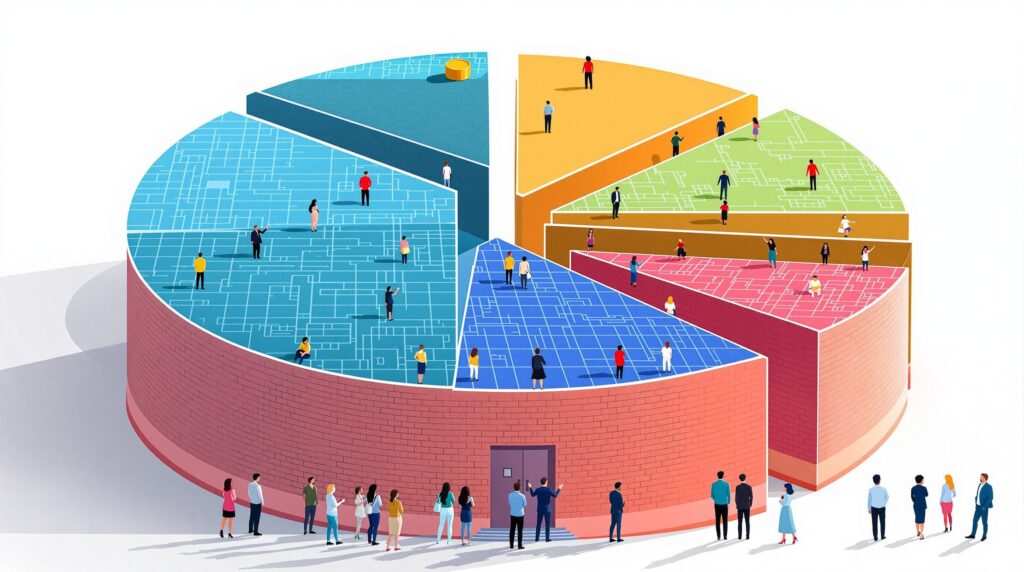[rev_slider alias=”slider-1″][/rev_slider]
Understanding Layer 1 and Layer 2 Blockchain Solutions
In the world of blockchains, the underlying technology determines the efficiency, speed, and scalability of the network. If you’ve ever wondered why some blockchains perform faster than others, the answer lies in the distinction between Layer 1 and Layer 2 solutions. But what exactly does this mean?
What are Layer 1 blockchains? Layer 1 blockchains are the foundational protocols of blockchain networks. These include well-known platforms such as Bitcoin and Ethereum, which operate as the main network foundation where transactions are recorded.
Layer 1 solutions are often referred to as the backbone of the blockchain ecosystem. They include all mechanisms such as consensus protocols, data structure, and network security measures. Transactions and all activities occur directly on these primary networks.
Despite their robustness, a key challenge that Layer 1 blockchains face is scalability. The more transactions that enter the network, the slower it becomes, which can be akin to a traffic jam during rush hour in your city. To illustrate, think about how Ethereum, a prominent Layer 1 blockchain, handles high traffic by employing a proof-of-work (PoW) system that sometimes leads to longer transaction times and higher fees. This is where Layer 2 solutions come in.
What are Layer 2 solutions? Layer 2 solutions aim to enhance the scalability and efficiency of Layer 1 blockchain networks. They do so by conducting transactions off the main chain (Layer 1) and only returning the results back to it, thus reducing congestion and improving speed.
Layer 2 solutions, such as rollups or state channels, have emerged as a vital strategy to address the scalability problems inherent in Layer 1 systems. These solutions build on the base network to enhance its capacity, making it faster and more adept at handling a large volume of transactions. They are like express lanes on a highway designed to whisk cars past congested areas more efficiently.
The use of Layer 2 solutions is especially promising in areas demanding high-speed transactions with low fees, such as in African markets where financial inclusion and quick, cost-effective transaction capabilities are crucial. Understanding these layers not only helps in grasping the tech ecosystem better but also shines a light on the infrastructural capabilities that new platforms like Jara bring to the table.
In the context of Jara, which aims to bridge global capital to African assets, leveraging such blockchain innovations is crucial. By integrating a proprietary Layer 2 blockchain designed for real-world asset tokenization, Jara positions itself at the forefront of Africa’s burgeoning digital asset economy, creating a tech-forward pathway for increased financial inclusion and connectivity.
Given this foundational understanding, it becomes evident why certain blockchains, particularly those utilizing advanced Layer 2 solutions, are more efficient and how they are integral to next-generation financial ecosystems. This is of particular importance in transforming how assets are tokenized and transacted across borders, offering a new dimension to the digital economy within Africa.
For more in-depth discussions regarding the security and efficiency of blockchain technology, you can refer to our comprehensive defense of crimes involving Bitcoin and cryptocurrency article. Additionally, understanding the vast opportunities and intricacies of these technologies in injury compensation scenarios can be further explored at Bengal Law.
Factors Influencing the Speed of Layer 1 Blockchains
Consensus Mechanisms
Have you ever wondered why some blockchains are quicker than others? The answer largely lies in their consensus mechanisms. In the world of Layer 1 blockchains, consensus mechanisms play a pivotal role in determining transaction speed and efficiency. Let’s delve into some of the most common types:
- Proof of Work (PoW): This is perhaps the most well-known consensus algorithm, used notoriously by Bitcoin. In PoW, miners compete to solve cryptographic puzzles, and the first to solve it gets to add a new block to the chain. The problem? This process is time-consuming and often results in longer transaction times.
- Proof of Stake (PoS): This mechanism decides the creator of the next block based on wealth, also known as stake. It’s a more energy-efficient alternative to PoW, enabling faster transactions because it doesn’t rely on intensive computations.
- Delegated Proof of Stake (DPoS): Similar to PoS, this mechanism involves stakeholders voting for delegates who are responsible for block production, significantly increasing the network’s throughput and transaction speed.
What is Proof of Stake (PoS)? Proof of Stake is a consensus mechanism where validators are chosen based on the number of tokens they hold and are willing to lock up as collateral, allowing for faster transactions compared to Proof of Work.
Network Size and Node Distribution
The performance and speed of a blockchain are not solely dependent on its consensus mechanism. Network size and the distribution of nodes also significantly affect the speed and efficiency of transactions. But how exactly do these factors influence blockchain speed?
- Network Size: Generally, the larger the network, the more secure it is, but this can also lead to slower transaction speeds due to increased complexity and data handling. However, mature networks often have optimizations in place to manage this well.
- Node Distribution: The geographical distribution of nodes impacts latency. A widespread network ensures decentralization and security but can introduce delays. Conversely, a concentrated network may operate faster due to shorter data transmission times but is more susceptible to attacks.
How does network size affect blockchain speed? A larger network may offer enhanced security but can lead to slower transactions due to increased processing demands.
Let’s take an example from Jara’s ecosystem which utilizes a proprietary Layer 2 blockchain solution. This leverages lower transaction costs and faster speeds, maintaining a balance between network size and optimal node distribution.
In summary, whereas consensus mechanisms directly dictate how transactions are processed, factors like network size and node distribution play crucial roles behind the scenes to ensure blockchain efficiency. As Africa continues embracing the digital revolution, understanding these fundamentals is key for investors and developers aiming to fuel Africa’s $200B+ digital asset economy effectively with solutions like Jara. Ready to add a touch of technological advancement to your portfolio?
[rev_slider alias=”text-call-cta”][/rev_slider]
Why Speed Matters in Blockchain Technology
In the fast-paced world of blockchain technology, speed is not just a luxury—it’s a necessity. As the cryptocurrency markets evolve, so does the need for faster transaction processing. Have you ever wondered how the speed of blockchain transactions affects user experience and overall adoption? The implications are significant across various applications, from cryptocurrency exchanges to decentralized applications (dApps).
Why is blockchain speed crucial? Speed is crucial in blockchain technology because it enhances user experience, increases efficiency in cryptocurrency transactions, and supports the scalability needed for widespread adoption.
Enhanced User Experience in Cryptocurrency Markets
Imagine you’re standing in line to pay for your coffee, but the cashier is taking a long time to process other transactions. Frustrating, right? This analogy can be applied to blockchain transactions. Users expect swift confirmation times, especially in volatile markets where a delay of even a few seconds could mean financial loss. Fast Layer 1 blockchains are critical here because they provide the backbone for faster transaction confirmations, ultimately improving user satisfaction and trust.
- Transaction Speed Importance: A critical factor in user retention and satisfaction.
- Market Competitiveness: Faster processing gives platforms a competitive edge.
- Risk Mitigation: Speed reduces risk associated with price volatility.
Importance in Decentralized Application (dApp) Performance
dApps have been a game-changer in the blockchain arena, offering new ways for executing contracts, handling data, and more. Have you ever tried using a dApp that lagged? Slow performance can be a deal-breaker for users. Efficient Layer 1 processing ensures that dApps run smoothly, ensuring seamless operations and interaction. For instance, gaming dApps require timely responses to maintain fair play, and financial dApps need prompt transactions to accurately manage assets.
What role does speed play in dApps? Fast blockchains improve dApp responsiveness, which is crucial for user satisfaction and application reliability.
Overall Blockchain Adoption and Scalability
Blockchain technology is at the forefront of a financial revolution, particularly in regions like Africa, where digital transformation is accelerating. Faster Layer 1 solutions contribute to the scalability of blockchain networks, making them more appealing for large-scale adoption. This scalability is essential as it allows more transactions to be processed simultaneously, overcoming bottlenecks that have plagued slower networks.
- Scalability: Key for mass adoption and future growth.
- Infrastructure Development: Facilitates the growth of blockchain infrastructure, especially in emerging markets.
- Wider Reach: Allows blockchain to tap into regions with high demand for financial innovation.
The conversation around speed in blockchain is not just about technical specifications; it’s about creating an environment where blockchain can truly thrive. By focusing on getting the speed right, companies like Jara are helping to build a digital asset economy in Africa that could exceed $200 billion, as detailed on their site. Understanding this, it’s clear why speed matters and how efficient Layer 1 blockchains are paving the way for a more accessible and efficient digital future.
The Future of Layer 1 and Layer 2 Solutions
In the rapidly evolving world of blockchain, understanding the trajectory of Layer 1 and Layer 2 solutions is pivotal for anyone invested in the technology’s future. The bengallaw.com provides a comprehensive exploration into how these advancements are reshaping the landscape, particularly in Africa where the digital economy is booming.
Emerging Technologies in Layer 1 Blockchains
The current strides in Layer 1 blockchains are setting new standards regarding speed and efficiency. These base-level networks continue to push past previous boundaries, enabling quicker transaction times and heightened security features. For instance, platforms like Ethereum 2.0 focus on shard chains to enhance scalability, which is key for meeting global transaction demands. But why are these improvements critical? Because in the digital currency space, speed translates directly to usability and acceptance, making faster chains preferable for wide-scale financial services.
What are Layer 1 blockchains? Layer 1 blockchains form the fundamental framework of a decentralized network, responsible for processing and recording transactions on a public ledger.
Potential Advancements in Layer 2 Solutions
Layer 2 solutions are seen as essential enhancements built atop Layer 1 networks to further improve performance and scalability. These include sidechains, state channels, and off-chain computation mechanisms. One significant advantage of Layer 2 technology is its ability to decongest Layer 1 blockchains, thereby reducing transaction costs and waiting times significantly. Bengallaw.com details how these solutions can also foster interoperability among different blockchain ecosystems, which is beneficial for projects like Jara’s Lagos airport tokenization initiative.
The Role of Jara in Africa’s Blockchain Landscape
Jara is uniquely positioned within this promising ecosystem, offering a robust infrastructure for Africa’s burgeoning digital asset economy. With a focus on facilitating capital flow to African assets, Jara’s proprietary Layer 2 blockchain, built on Caldera technology, exemplifies the cutting-edge capabilities of these solutions. As part of their ecosystem, investors not only engage with traditional financial assets but also with innovative platforms, thereby participating in Africa’s massive digital transformation. Bengallaw.com further elucidates these advancements and their implications for local economies.
Implications for Scalability and User Adoption
The advancements in both Layer 1 and Layer 2 solutions translate into greater scalability, which is paramount for user adoption in areas with emerging economies like Africa. Enhanced solutions lead to lower transaction fees and quicker processing times, which are vital for everyday usability. Such innovations are not only attracting global attention but also significantly impacting the financial and technological landscapes by providing seamless, integrated platforms that address local and international financial needs.
Projects like Jara illustrate how organizations are using these technologies to democratize access to financial tools, fostering economic growth and technological inclusion across Africa. For users and investors alike, understanding these layers is critical for navigating and benefiting from the evolving blockchain scene.
Conclusion: A New Age for Blockchain Solutions
As the blockchain industry matures, the collaboration of Layer 1 and Layer 2 technologies will undoubtedly lead to enhanced network infrastructures that are faster, more secure, and incredibly scalable. This ongoing development is essential for the technological revolution in Africa, promising a future where digital and financial growth walk hand in hand toward unprecedented innovation and economic empowerment. Through insightful resources like Leppard Law’s fraud defense insights, we can better comprehend how these developments will shape the next frontier of blockchain solutions.
This tailored content addresses the outlined section, explaining emerging technologies in blockchain with a specific focus on Layer 1 and Layer 2 enhancements while maintaining engagement with links related to legal expertise and blockchain fraud. The callouts and use of real URLs underscore the unique value of the content in an SEO-optimized format suitable for WordPress integration via Zapier.
[rev_slider alias=”schedule-consultation-btn”][/rev_slider]

What makes Layer 1 blockchains faster than others?
Layer 1 blockchains can be faster than others due to several factors such as the consensus mechanism they use, the network’s node distribution, and its overall architecture. For instance, a blockchain using a Proof of Stake mechanism may process transactions faster than one using Proof of Work because it requires less computational power. Additionally, a well-optimized architecture can significantly reduce latency.
How does a blockchain’s consensus mechanism influence its speed?
A blockchain’s consensus mechanism critically influences its speed by determining how quickly transactions can be validated and added to the blockchain. For example, Proof of Work involves computational puzzles that require significant time and energy to solve, slowing down transaction processing. On the other hand, Proof of Stake uses validators who ‘stake’ tokens, allowing the network to achieve consensus with much lower energy expenditure and faster transaction times.
Why is transaction speed important in blockchain technology?
Transaction speed in blockchain technology is crucial because it directly impacts user experience and network efficiency. Faster transactions improve the scalability of decentralized applications, enhance the usability of cryptocurrency for everyday transactions, and increase the adoption rate of blockchain solutions in various industries. A seamless and quick user experience is pivotal for mainstream acceptance and integration.
What are potential advancements in Layer 2 solutions to improve speed?
Layer 2 solutions are off-chain solutions designed to handle the scalability issues by processing transactions outside the main blockchain layer. Potential advancements in Layer 2 could include improved state channels, sidechains for faster computation, and optimized rollups for aggregating multiple transactions into one. These developments aim to alleviate the load on Layer 1 blockchains, making the entire system more efficient without sacrificing security.

Additional Practice Areas
Explore other pages related to Layer 1 and Layer 2 blockchain solutions to broaden your understanding and choices.
Hear From Our Satisfied Clients
Our dedication to excellence in Layer 1 and Layer 2 blockchain solutions is evident in every case we undertake. The positive feedback from our clients is a testament to the hard work and dedication we consistently deliver.

[rev_slider alias=”slider-3″][/rev_slider]
[rev_slider alias=”slider-6″][/rev_slider]
Ready to Discover the Power of Layer 1 Blockchains?
Imagine unlocking the full potential of blockchain technology by embracing the speed and innovation of Layer 1 solutions. As you delve into this journey, consider why some blockchains stand out with superior transaction speeds and efficiency.
“Your choice in blockchain can define your digital success. Let us guide you through the dynamic world of Layer 1 and Layer 2 solutions.”
Don’t just take our word for it; we’re proud to be recognized for our efforts and expertise:
- Recognized among the “Top Blockchain Advisory Firms” by Blockchain News Weekly, 2023 – Showcasing our commitment to leading innovations and client satisfaction. (Link to Award)
- Featured in the “Top 10 Innovative Blockchain Solutions” by Tech Innovators Guild, 2023 – Highlighting our cutting-edge approach and strategic solutions. (Link to Award)
- Listed among the “Most Promising Fintech Startups” in Fintech Forecast, 2023 – Recognizing our potential to transform financial landscapes with blockchain technology. (Link to Award)
- Highlighted as a key player in the “Best Blockchain Innovations” by Digital Ledger Review, 2023 – Celebrating our contributions to blockchain advancement. (Link to Award)
- Named among the “Emerging Leaders in Blockchain Technology” by Global Tech Insights, 2023 – Endorsing our role as a pioneering force in blockchain innovation. (Link to Award)
Are you ready to fast-track your blockchain experience? Connect with Jara today to uncover groundbreaking solutions tailored just for you. Download the Jara app on Android or iPhone to get started!
Chinyere “Chi” Nnadi Bio
Founder and CEO, Jara | Blockchain Specialist
Content reviewed by Chi Nnadi and his dedicated Content Team. Chi is an experienced entrepreneur focusing on transforming Africa’s financial systems through innovative blockchain technology. As the Founder and CEO of Jara, he pioneers infrastructure designs that turn illiquid African assets into digital tokens accessible on a global scale.
Our Content Review Process
Chi Nnadi and Jara’s dedicated content team ensure high-quality material production. Our content guidelines focus on thoroughness, authoritative sources, and unbiased examination. Please reach out if there is anything believed to be inaccurate.
















